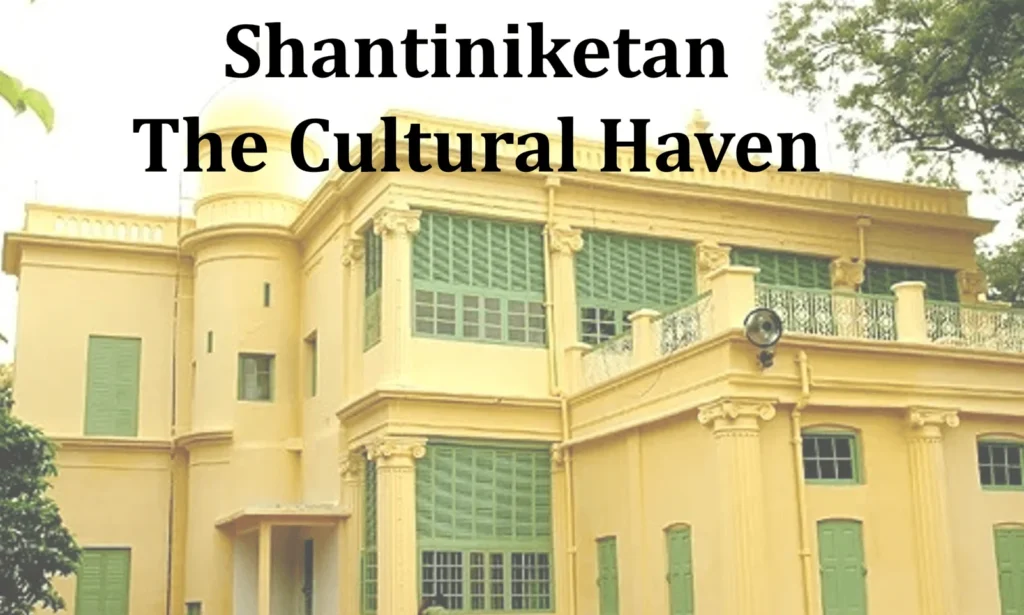
Shantiniketan, a name that reverberates with artistic brilliance and cultural significance, is a town in the Birbhum district of West Bengal, India. Shantiniketan has placed itself significantly in India and around the world. Moreover, it has successfully and uniquely blended art and culture with learning. All individuals who are drawn to creativity and the natural world gravitate toward it. Through this article I will try to put before you the long journey of Shantiniketan in a summarized way.
History of Shantiniketan
The history of Shantiniketan is closely tied to the vision and contributions of the renowned Indian poet, philosopher, and Nobel laureate, Rabindranath Tagore. Shantiniketan, which means “Abode of Peace” in Bengali, basically started as a small ashram (spiritual retreat) in 1863. It was established by Maharishi Debendranath Tagore, father of Rabindranath Tagore. Apart from academics meditation and spiritual pursuits were also practiced at this center.
Rabindranath Tagore established a school here in 1901 with a small group of students after taking over the ashram’s administration. Here he emphasized on practical learning and taught his disciples to connect to the nature. After all, the focus of this school was entirely on the holistic and unique style of education. Over the time, Tagore’s educational experiment gained recognition. Later in 1921, it was upgraded to the status of a university called Visva-Bharati. Communication between world and India is what “Visva-Bharati” meant. Tagore’s educational philosophy at Shantiniketan was deeply influenced by his belief in the integration of nature, art and culture with academics. Besides, the traditional way of education, he laid emphasis on outdoor learning. Basically, he promoted practice of music, dance and art in open air.

Shantiniketan became a hub for the cultural renaissance of Bengal and India. People from all over the world, like scholars, artists and thinkers came to Shantiniketan. They shared their ideas and sharpened their creative skills. Unquestionably, during the Indian independence movement, Shantiniketan became a center for political discussions and activities. Many prominent leaders, including Mahatma Gandhi, visited the institution.
Places not to be missed in Santiniketan
Rabindra Bhavana
- Founded in 1942
- Focal point of Visva Bharati
- Houses a museum, archives, library and more.
- Contains a significant part of Rabindranath Tagore’s manuscripts, correspondence, paintings, and sketches.
- Established by Rabindranath Tagore’s son, Rathindranath Tagore, as a memorial museum and research center for Tagore studies.
Uttarayana Complex
- It is located in the north portion of the town.
- Altogether it features five houses built by Rabindranath Tagore: Udayan, Shyamali, Konark, Udichi, and Punascha
- Beautifully landscaped gardens designed by Rathindranath Tagore
- Besides the above houses, Shyamali and Konark are mud houses. They have exquisite relief work by Kala Bhavana students.
- Udayan is the most imposing house, reserved for important guests.
- Guha Ghar, a museum in memory of Rathindranath Tagore, is located here.
Ashram Complex
- Certainly, it is the oldest area of Santiniketan, built by Debendranath Tagore.
- Includes Santiniketan Griha and a stunning stained-glass prayer hall.
- Patha Bhavana, with frescoes by Nandalal Bose, emerged after Rabindranath Tagore’s arrival.
- There are various historic houses like Natun Bari, Kalo Bari, Dehali, Santoshalaya and many more. Afterall, they contribute to the complex’s historical significance.
Specialized Institutes
- Visva Bharati was established to promote culture and the arts.
- Specialized institutes such as Cheena Bhavana, Hindi Bhavana, Kala Bhavana, Sangit Bhavana and more were created to explore different fields.
- Many of these institutes feature unique and artistically decorated structures.
Sculptures by Ramkinkar Baij
- The landscape of Shantiniketan is adorned with sculptures by Ramkinkar Baij.
- These sculptures include larger-than-life figures of Santals (local tribal people), depicting scenes of everyday life.
- Notable sculptures include a Santal family, a group of workers, a thresher and Sujata, an elongated figure of one of Buddha’s disciples. (One of his sculpture is shown below.)
- Nandalal Bose, another renowned artist, created an environment where art became an integral part of life in Santiniketan.

Conclusion
In Conclusion, Shantiniketan is still a place where culture and smart thinking are very important. Many famous and intellectual people have come from here, like writers and politicians. Therefore, this proves that the vision of Tagore is still alive in the walls and atmosphere of Santiniketan.
Shantiniketan becomes the 42nd site of India to be listed in the UNESCO world Heritage site. Indeed, it has presented an example for the modern time institution which believe in having lavish infrastructure that simplicity can never be defeated. A trip to Shantiniketan is like taking a deep breath and entering India’s heart for those who wish to learn more about its past and artistic side.

